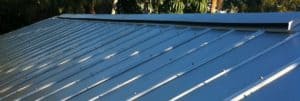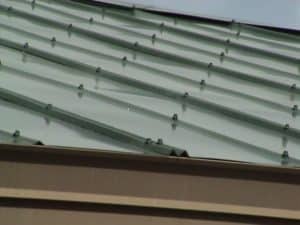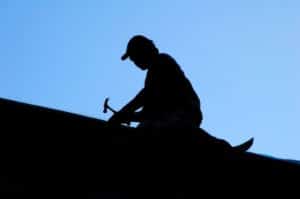WHAT RESPONSIBLE METAL ROOFING CONTRACTORS WANT YOU TO KNOW ABOUT THROUGH-FASTENED METAL ROOFING
The increased use of metal roofing is obvious to just about everyone at this point. Whether it is for commercial, industrial, residential or agricultural applications, it is virtually impossible to miss the fact that more and more property owners are turning to metal.

At the same time, the face of the building products industry is changing rapidly. More and more product decisions and purchases are being made at “big box” retailers. Whether homeowners choose to do their own installation or have their own “remodeling guy” do it, the big boxes are where those decisions are being made. And, to top it all off, the internet serves as a huge resource for homeowners who may be considering various building material purchases, allowing them to learn and discover essentially as much as they wish.
Because of the exactness required by the intricacies in installing today’s quality metal roofing systems, the higher quality products are not available through the big boxes. The end result is that property owners sometimes get excited by what they learn about metal roofing from the internet. They see durable and lasting products that they can easily visualize on their homes. Too often, though, their next stop is at the big box or engaged in a conversation with their local roofer or remodeling guy and things begin to go south. Through these sources, they are often introduced to metal roofing products that were never intended for residential use. The internet, on deeper examination, is full of stories of homeowners who have chosen those products only to later be terribly disappointed by the end results.
It is critical that anyone who is considering a metal roof for their home be aware of the various types of available products and the differences between them.
Low end metal roofing consists of panels called “through-fastened” panels. Also known by names such as 5V Crimp, R Panel, “sheet” roofing, and “ag sheet”, these products are all very similar and carry one rather serious common feature. These are the products most commonly available through big boxes and lumberyards, as well as through contractors who are not dedicated to metal roofing. The common feature is that they have fasteners which pierce directly through the panels and are exposed to the weather.

These exposed fasteners are in contrast to concealed fasteners that are protected from the weather by an adjoining metal panel. An additional factor with most concealed fasteners is that their method of fastening has built-in allowance for the natural expansion and contraction of the metal roofing panels with temperature changes. This is usually accomplished by having the concealed fastener actually hold something called a “fastening clip” in place rather than hold the roof panel itself solid to the structure. The fastening clips then hold the metal panels securely but they allow the panels to float some with expansion and contraction. Some concealed panel fasteners, rather than being dependent upon clips, have other ways to accommodate the metal’s expansion and contraction. In some cases, this is accomplished through “accordion fold” pleats in the metal which absorb movement and in other cases there is a fastening flange on the panels with pre-punched slots to hold the fasteners. The issue with pre-punched slots is that the installer must ensure fastener placement exactly in the middle of each clot or else the panels will be put in a bind with expansion and contraction resulting in ripples in the panels or fastener issues.
Exactly how much metal expansion and contraction are we talking about? A 24’ long (which would not be an unusual rafter length) piece of steel roofing can have movement of about three-tenths of an inch. When you think of a through-fastened product that has no built-in allowance for that expansion, you can easily see how the pressure which is placed on fasteners could fatigue or damage them, as well as the potential for the holes to elongate over time. When the holes elongate, the seal between the washer and the metal is broken. Water intrusion then takes place, leading not only to leaks around the screws but also to rusting of the hole and eventually the fastener.
Aside from understanding the fastening method and potential issues, there is another common misperception with lower-end corrugated metal roofing panels. Many of them are produced from galvalume. Unfortunately, hearing this can mislead property owners into thinking the product is aluminum rather than steel. Galvalume, however, is carbon steel at its core. It differs from galvanized steel in that the anti-corrosive metallic on galvalume is an aluminum-zinc alloy whereas on galvanized it is a zinc-aluminum alloy. However, galvalume is still steel and prone to the red rust which steel typically exhibits over time.
Not to make things even more confusing but there are various grades of galvalume and galvanized and, unfortunately, because through-fastened panels are already competing for the low end of the metal roofing industry, lower grade steels are sometimes used. According to the Metal Construction Industry, the minimum quality level for galvanized steel used in residential roofing should be G90. For galvalume, the minimum quality should be AZ50 for painted products and AZ55 for mill finish or clear-coated products.
The cost to become a manufacturer of through-fastened metal roofing panels is not all that high. There are countless producers across the United States and Canada. Some are of high integrity and quality and some are not. If you are considering purchasing a through-fastened metal roof and the manufacturer cannot certify to you that it meets these minimal levels of quality as put forth by the Metal Construction Association, then you should seek out a difference supplier. Always remember that the warranty you receive is only as strong as the company that issues it. Additionally, there is a “secondary metals market” and sometimes these metals find their way into the low end of metal roofing. These, in essence, are coils of steel that have been rejected at some point due to quality defects. They may very well meet the minimum standards discussed above but, despite that, they still have quality problems that will affect the performance of the final product over time. Just as you make sure that your manufacturer meets the minimum metal standards, you should also verify that they are using “primary” and not “secondary” metal. Lower grade steels will often fall prey to corrosion issues and other problems in a short period of time, leaving the homeowner very unhappy with their roofing decision.
Just as there can be variations in metal quality, there can also be variations in paint quality. And, again, because through-fastened products are on the lower end of the market as far as quality and price, there is ongoing downward pressure on coatings quality as well. The quality of the coating can make the difference in terms of whether your roof still looks new in 30 years or aged in less than ten. It is generally recognized by most authorities that the only paint systems of quality acceptable for residential use in terms of fade, chalk, and overall durability, are Kynar / Hylar systems, also called PVDF II coatings. There are many lower grade finishes available including acrylics and various polyesters but homeowners who are seeking a roof that will last, stay beautiful and add value to their home will be very disappointed by the performance of these lower grade paint finishes.

Another common concern regarding through-fastened panels is their installation. At this point, all of the major national manufacturers of these products suggest that they be installed over solid decking only along with a quality underlayment, particularly if it is a residential installation. This is to help minimize problems with expansion and contraction and also to eliminate the potential for attic condensation issues. Installation on pole buildings and barns (the predominate use of these panels) can sometimes be done over battens or purlins but that is because there is a big difference in terms of ventilation and other issues between a barn and a house. Unfortunately, even many contractors do not know this and there are countless stories of the improper use of these products on houses, resulting in problems that were expensive to repair as well as very damaging.
Again, it is important that homeowners who make the decision to invest in a metal roof be aware of exactly what it is that they are buying. Oftentimes, unfortunately, the products they purchase from roofing contractors or the big boxes are not at all the products they have seen, read and heard about, and think they are buying. Without careful research, they can fall into decisions that they will very much regret just a few months later.


Tags
Subscribe to American Metal Roofs's Blog

Comments